Hospitality Provision in Travel & Tourism: Integration and Planning
VerifiedAdded on 2024/06/25
|19
|4297
|51
Report
AI Summary
This report provides a comprehensive analysis of the hospitality industry within the context of travel and tourism. It begins by discussing the interrelationships between hospitality and the broader travel and tourism sectors, highlighting key components such as hotels, restaurants, nightclubs, contract food service providers, and membership clubs, as well as travel services, tourism services, conferences, events, and visitor attractions. The report then examines the implications of integration, both vertical and horizontal, on the hospitality industry, focusing on branding policies, market control, improved market share, enhanced service quality, and the reduction of independent businesses, using examples like Accor Hotels' acquisition of Fairmont and Marriott's takeover of Starwood Hotels & Resorts. Finally, the report outlines a hospitality business plan for a fine dining restaurant named "The Grandeur Room," detailing the development concept, market research using PESTLE and SWOT analyses, and target market considerations, aiming to improve market share by five percent within four years; this document is available for study and reference on Desklib, a platform offering a wide range of academic resources.
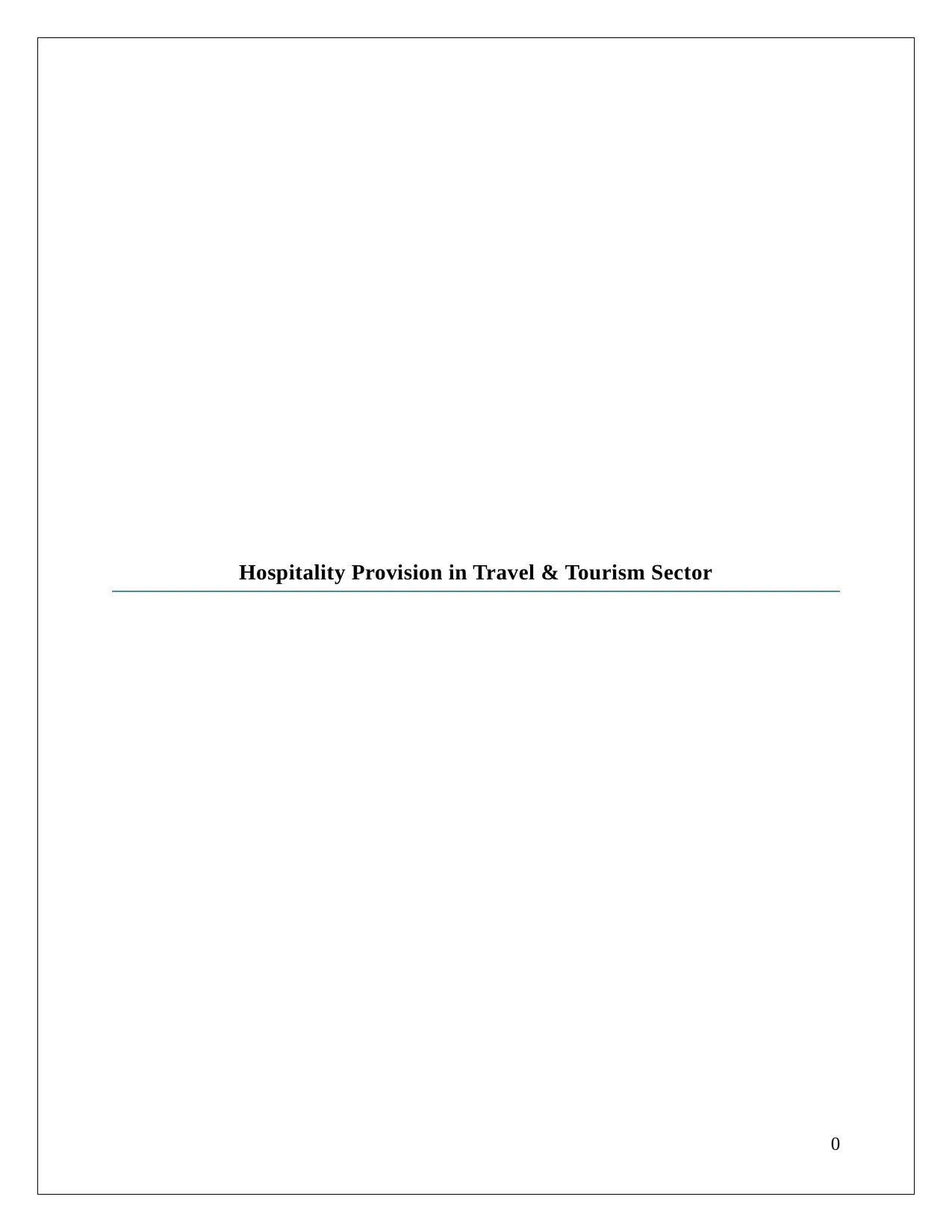
Hospitality Provision in Travel & Tourism Sector
0
0
Paraphrase This Document
Need a fresh take? Get an instant paraphrase of this document with our AI Paraphraser
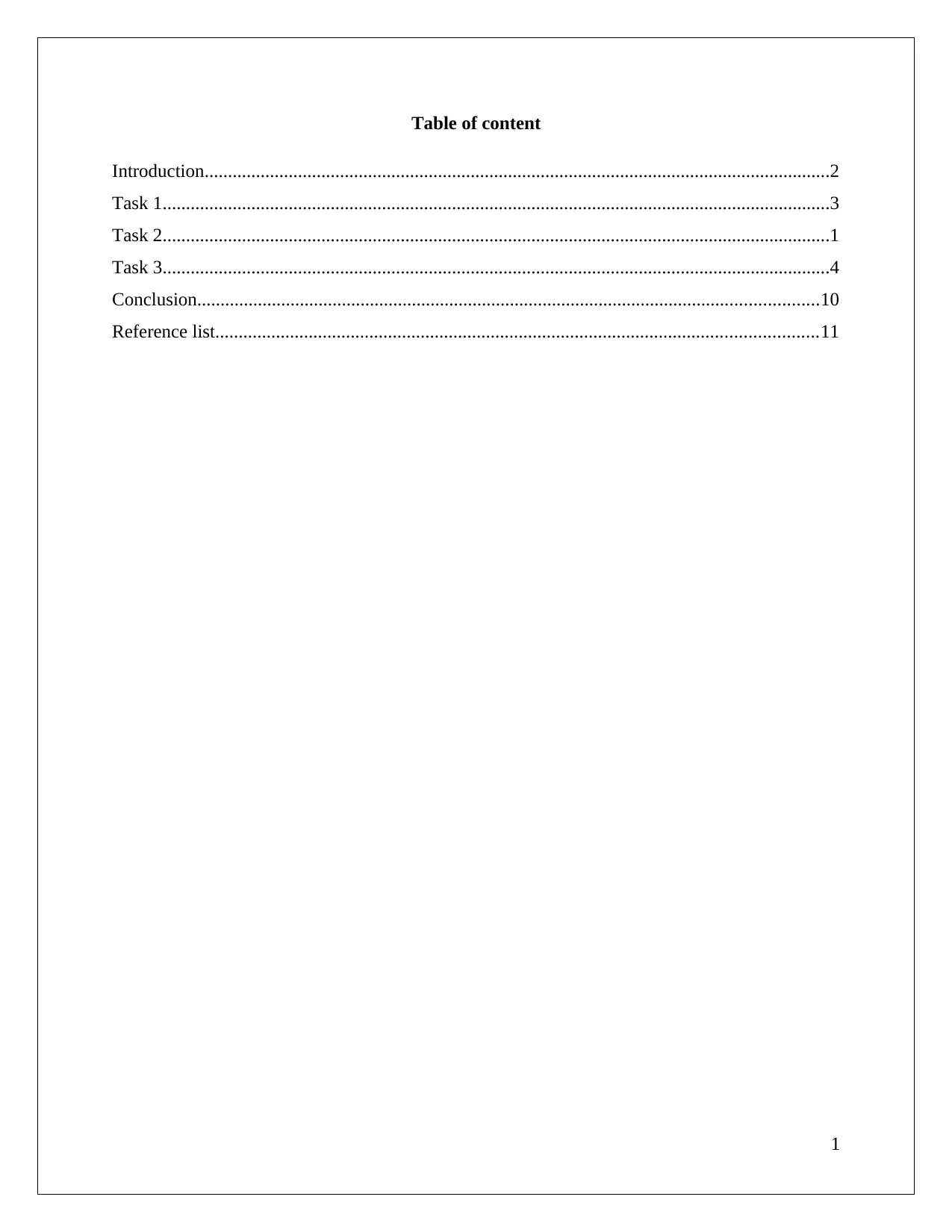
Table of content
Introduction......................................................................................................................................2
Task 1...............................................................................................................................................3
Task 2...............................................................................................................................................1
Task 3...............................................................................................................................................4
Conclusion.....................................................................................................................................10
Reference list.................................................................................................................................11
1
Introduction......................................................................................................................................2
Task 1...............................................................................................................................................3
Task 2...............................................................................................................................................1
Task 3...............................................................................................................................................4
Conclusion.....................................................................................................................................10
Reference list.................................................................................................................................11
1
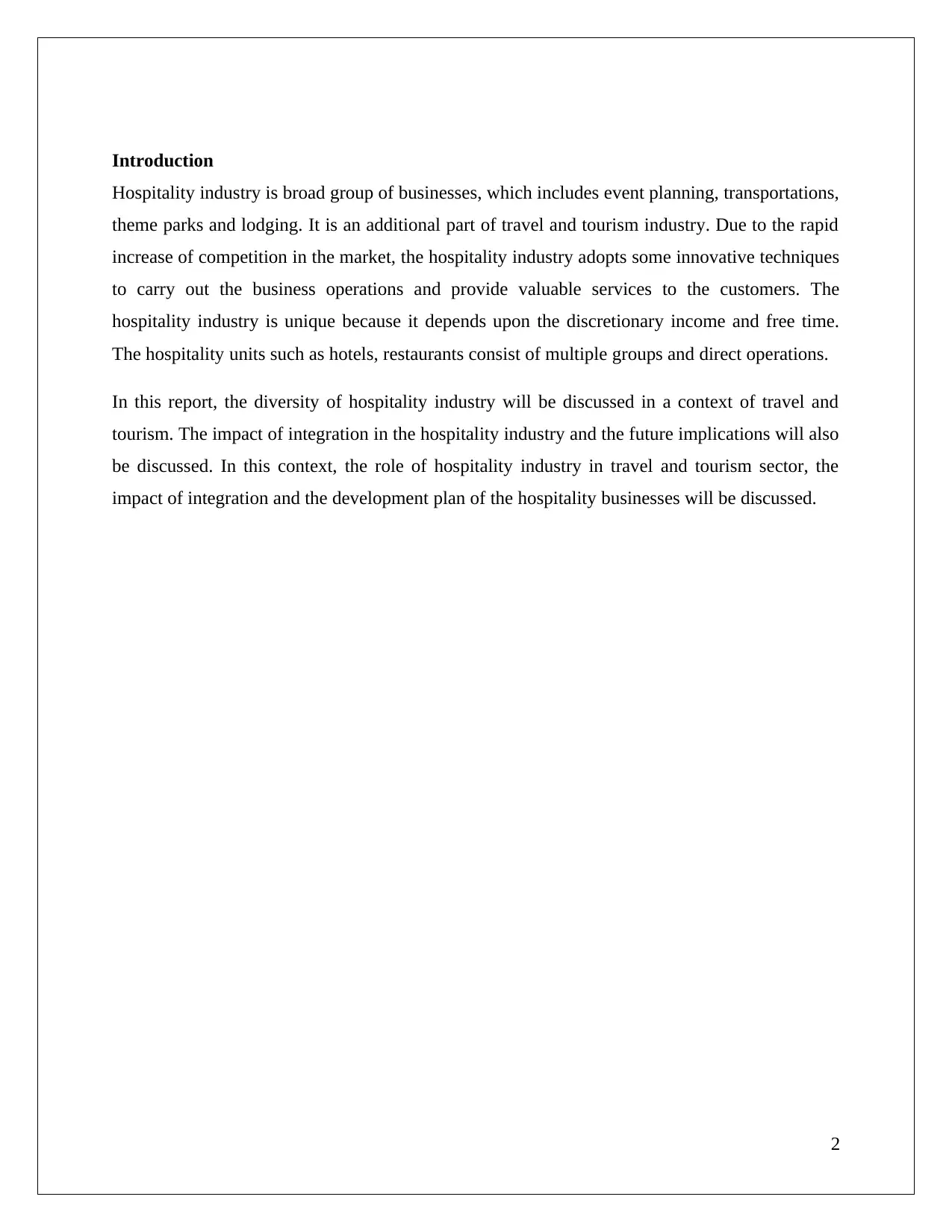
Introduction
Hospitality industry is broad group of businesses, which includes event planning, transportations,
theme parks and lodging. It is an additional part of travel and tourism industry. Due to the rapid
increase of competition in the market, the hospitality industry adopts some innovative techniques
to carry out the business operations and provide valuable services to the customers. The
hospitality industry is unique because it depends upon the discretionary income and free time.
The hospitality units such as hotels, restaurants consist of multiple groups and direct operations.
In this report, the diversity of hospitality industry will be discussed in a context of travel and
tourism. The impact of integration in the hospitality industry and the future implications will also
be discussed. In this context, the role of hospitality industry in travel and tourism sector, the
impact of integration and the development plan of the hospitality businesses will be discussed.
2
Hospitality industry is broad group of businesses, which includes event planning, transportations,
theme parks and lodging. It is an additional part of travel and tourism industry. Due to the rapid
increase of competition in the market, the hospitality industry adopts some innovative techniques
to carry out the business operations and provide valuable services to the customers. The
hospitality industry is unique because it depends upon the discretionary income and free time.
The hospitality units such as hotels, restaurants consist of multiple groups and direct operations.
In this report, the diversity of hospitality industry will be discussed in a context of travel and
tourism. The impact of integration in the hospitality industry and the future implications will also
be discussed. In this context, the role of hospitality industry in travel and tourism sector, the
impact of integration and the development plan of the hospitality businesses will be discussed.
2
⊘ This is a preview!⊘
Do you want full access?
Subscribe today to unlock all pages.

Trusted by 1+ million students worldwide
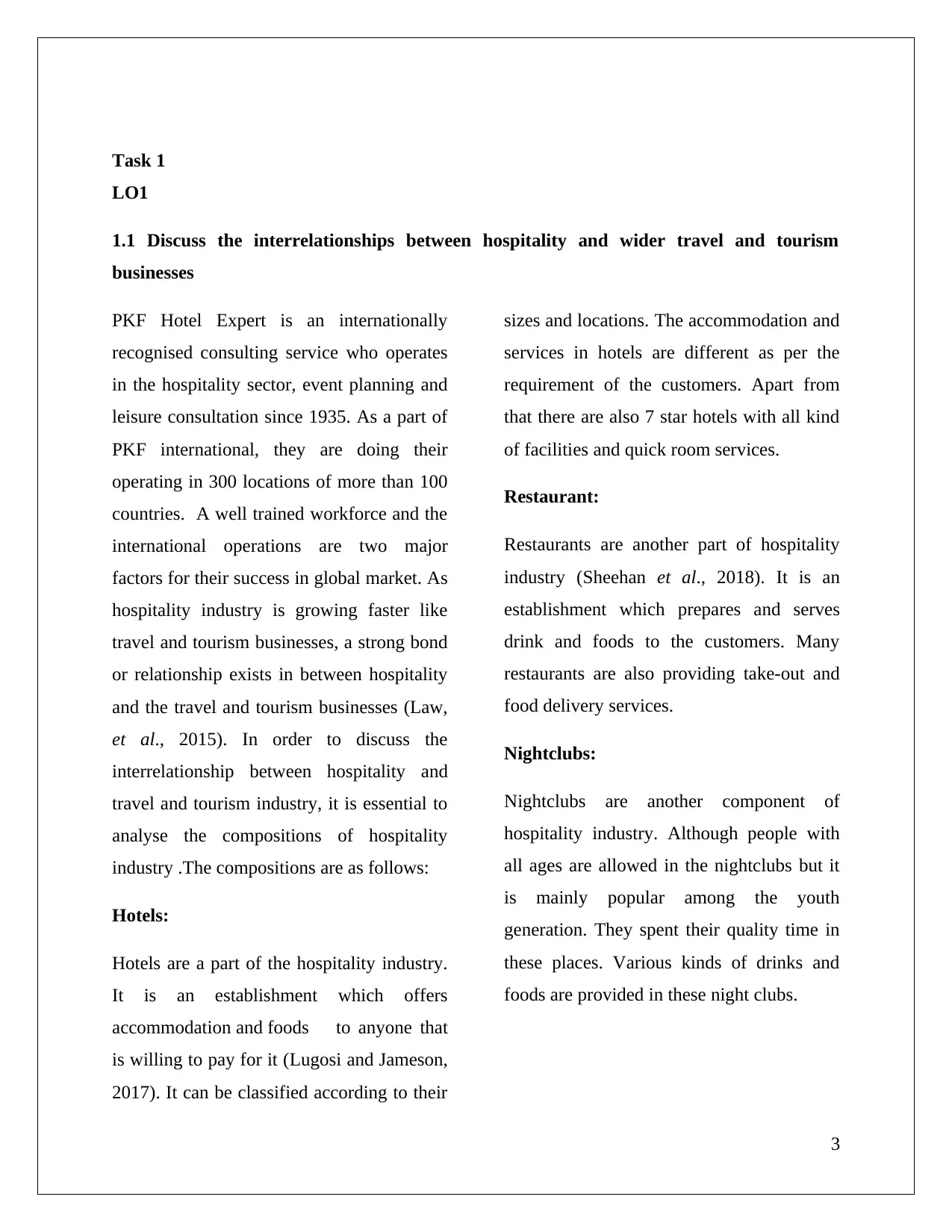
Task 1
LO1
1.1 Discuss the interrelationships between hospitality and wider travel and tourism
businesses
PKF Hotel Expert is an internationally
recognised consulting service who operates
in the hospitality sector, event planning and
leisure consultation since 1935. As a part of
PKF international, they are doing their
operating in 300 locations of more than 100
countries. A well trained workforce and the
international operations are two major
factors for their success in global market. As
hospitality industry is growing faster like
travel and tourism businesses, a strong bond
or relationship exists in between hospitality
and the travel and tourism businesses (Law,
et al., 2015). In order to discuss the
interrelationship between hospitality and
travel and tourism industry, it is essential to
analyse the compositions of hospitality
industry .The compositions are as follows:
Hotels:
Hotels are a part of the hospitality industry.
It is an establishment which offers
accommodation and foods to anyone that
is willing to pay for it (Lugosi and Jameson,
2017). It can be classified according to their
sizes and locations. The accommodation and
services in hotels are different as per the
requirement of the customers. Apart from
that there are also 7 star hotels with all kind
of facilities and quick room services.
Restaurant:
Restaurants are another part of hospitality
industry (Sheehan et al., 2018). It is an
establishment which prepares and serves
drink and foods to the customers. Many
restaurants are also providing take-out and
food delivery services.
Nightclubs:
Nightclubs are another component of
hospitality industry. Although people with
all ages are allowed in the nightclubs but it
is mainly popular among the youth
generation. They spent their quality time in
these places. Various kinds of drinks and
foods are provided in these night clubs.
3
LO1
1.1 Discuss the interrelationships between hospitality and wider travel and tourism
businesses
PKF Hotel Expert is an internationally
recognised consulting service who operates
in the hospitality sector, event planning and
leisure consultation since 1935. As a part of
PKF international, they are doing their
operating in 300 locations of more than 100
countries. A well trained workforce and the
international operations are two major
factors for their success in global market. As
hospitality industry is growing faster like
travel and tourism businesses, a strong bond
or relationship exists in between hospitality
and the travel and tourism businesses (Law,
et al., 2015). In order to discuss the
interrelationship between hospitality and
travel and tourism industry, it is essential to
analyse the compositions of hospitality
industry .The compositions are as follows:
Hotels:
Hotels are a part of the hospitality industry.
It is an establishment which offers
accommodation and foods to anyone that
is willing to pay for it (Lugosi and Jameson,
2017). It can be classified according to their
sizes and locations. The accommodation and
services in hotels are different as per the
requirement of the customers. Apart from
that there are also 7 star hotels with all kind
of facilities and quick room services.
Restaurant:
Restaurants are another part of hospitality
industry (Sheehan et al., 2018). It is an
establishment which prepares and serves
drink and foods to the customers. Many
restaurants are also providing take-out and
food delivery services.
Nightclubs:
Nightclubs are another component of
hospitality industry. Although people with
all ages are allowed in the nightclubs but it
is mainly popular among the youth
generation. They spent their quality time in
these places. Various kinds of drinks and
foods are provided in these night clubs.
3
Paraphrase This Document
Need a fresh take? Get an instant paraphrase of this document with our AI Paraphraser
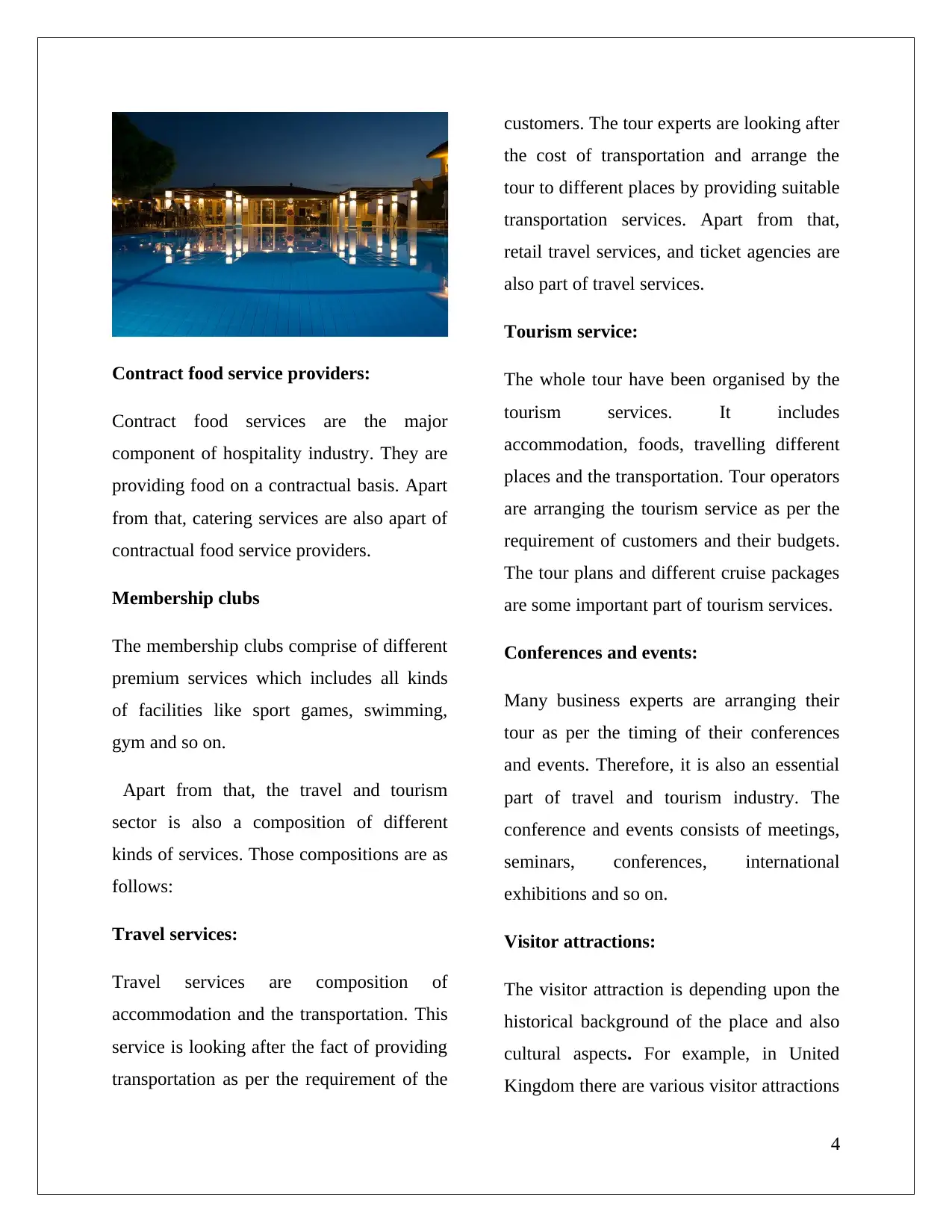
Contract food service providers:
Contract food services are the major
component of hospitality industry. They are
providing food on a contractual basis. Apart
from that, catering services are also apart of
contractual food service providers.
Membership clubs
The membership clubs comprise of different
premium services which includes all kinds
of facilities like sport games, swimming,
gym and so on.
Apart from that, the travel and tourism
sector is also a composition of different
kinds of services. Those compositions are as
follows:
Travel services:
Travel services are composition of
accommodation and the transportation. This
service is looking after the fact of providing
transportation as per the requirement of the
customers. The tour experts are looking after
the cost of transportation and arrange the
tour to different places by providing suitable
transportation services. Apart from that,
retail travel services, and ticket agencies are
also part of travel services.
Tourism service:
The whole tour have been organised by the
tourism services. It includes
accommodation, foods, travelling different
places and the transportation. Tour operators
are arranging the tourism service as per the
requirement of customers and their budgets.
The tour plans and different cruise packages
are some important part of tourism services.
Conferences and events:
Many business experts are arranging their
tour as per the timing of their conferences
and events. Therefore, it is also an essential
part of travel and tourism industry. The
conference and events consists of meetings,
seminars, conferences, international
exhibitions and so on.
Visitor attractions:
The visitor attraction is depending upon the
historical background of the place and also
cultural aspects. For example, in United
Kingdom there are various visitor attractions
4
Contract food services are the major
component of hospitality industry. They are
providing food on a contractual basis. Apart
from that, catering services are also apart of
contractual food service providers.
Membership clubs
The membership clubs comprise of different
premium services which includes all kinds
of facilities like sport games, swimming,
gym and so on.
Apart from that, the travel and tourism
sector is also a composition of different
kinds of services. Those compositions are as
follows:
Travel services:
Travel services are composition of
accommodation and the transportation. This
service is looking after the fact of providing
transportation as per the requirement of the
customers. The tour experts are looking after
the cost of transportation and arrange the
tour to different places by providing suitable
transportation services. Apart from that,
retail travel services, and ticket agencies are
also part of travel services.
Tourism service:
The whole tour have been organised by the
tourism services. It includes
accommodation, foods, travelling different
places and the transportation. Tour operators
are arranging the tourism service as per the
requirement of customers and their budgets.
The tour plans and different cruise packages
are some important part of tourism services.
Conferences and events:
Many business experts are arranging their
tour as per the timing of their conferences
and events. Therefore, it is also an essential
part of travel and tourism industry. The
conference and events consists of meetings,
seminars, conferences, international
exhibitions and so on.
Visitor attractions:
The visitor attraction is depending upon the
historical background of the place and also
cultural aspects. For example, in United
Kingdom there are various visitor attractions
4
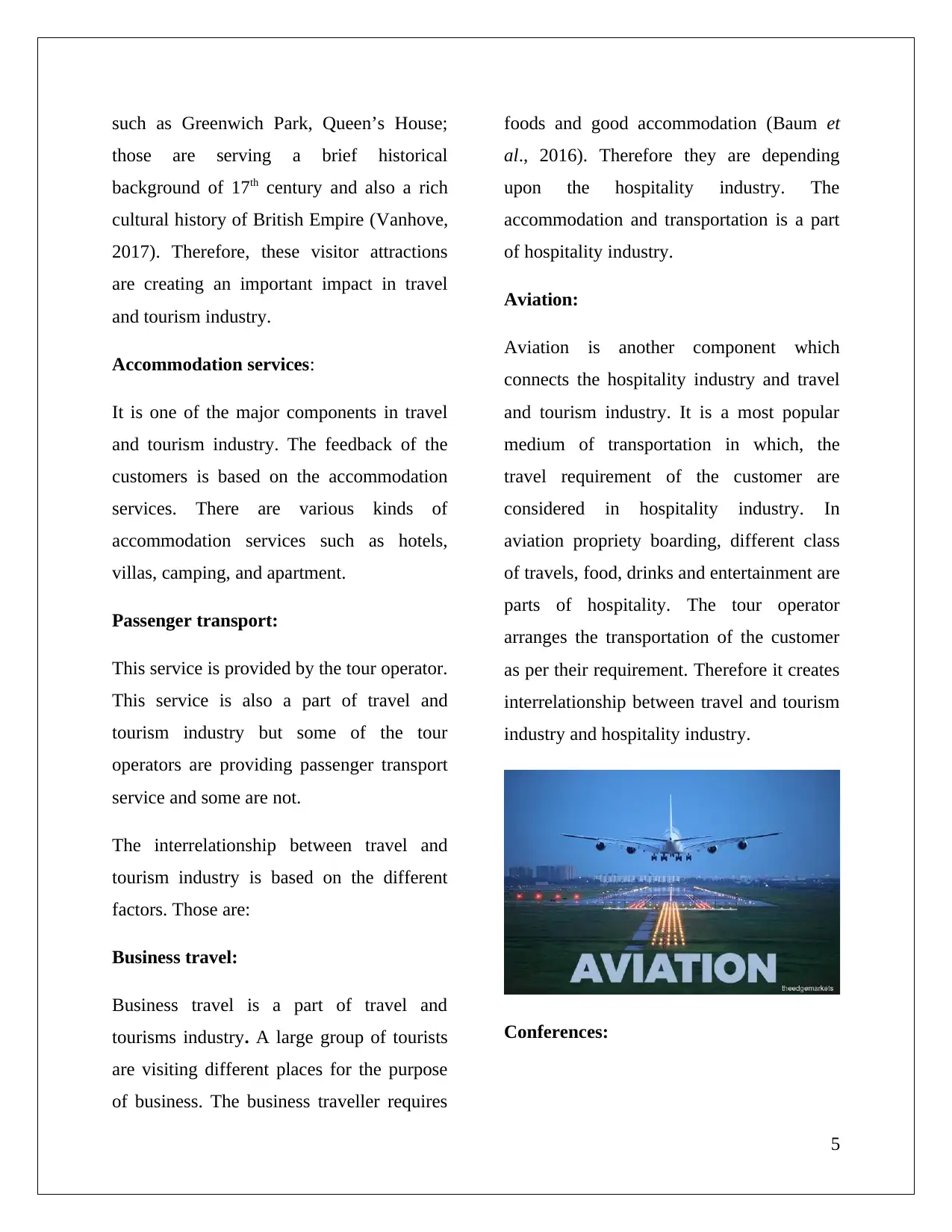
such as Greenwich Park, Queen’s House;
those are serving a brief historical
background of 17th century and also a rich
cultural history of British Empire (Vanhove,
2017). Therefore, these visitor attractions
are creating an important impact in travel
and tourism industry.
Accommodation services:
It is one of the major components in travel
and tourism industry. The feedback of the
customers is based on the accommodation
services. There are various kinds of
accommodation services such as hotels,
villas, camping, and apartment.
Passenger transport:
This service is provided by the tour operator.
This service is also a part of travel and
tourism industry but some of the tour
operators are providing passenger transport
service and some are not.
The interrelationship between travel and
tourism industry is based on the different
factors. Those are:
Business travel:
Business travel is a part of travel and
tourisms industry. A large group of tourists
are visiting different places for the purpose
of business. The business traveller requires
foods and good accommodation (Baum et
al., 2016). Therefore they are depending
upon the hospitality industry. The
accommodation and transportation is a part
of hospitality industry.
Aviation:
Aviation is another component which
connects the hospitality industry and travel
and tourism industry. It is a most popular
medium of transportation in which, the
travel requirement of the customer are
considered in hospitality industry. In
aviation propriety boarding, different class
of travels, food, drinks and entertainment are
parts of hospitality. The tour operator
arranges the transportation of the customer
as per their requirement. Therefore it creates
interrelationship between travel and tourism
industry and hospitality industry.
Conferences:
5
those are serving a brief historical
background of 17th century and also a rich
cultural history of British Empire (Vanhove,
2017). Therefore, these visitor attractions
are creating an important impact in travel
and tourism industry.
Accommodation services:
It is one of the major components in travel
and tourism industry. The feedback of the
customers is based on the accommodation
services. There are various kinds of
accommodation services such as hotels,
villas, camping, and apartment.
Passenger transport:
This service is provided by the tour operator.
This service is also a part of travel and
tourism industry but some of the tour
operators are providing passenger transport
service and some are not.
The interrelationship between travel and
tourism industry is based on the different
factors. Those are:
Business travel:
Business travel is a part of travel and
tourisms industry. A large group of tourists
are visiting different places for the purpose
of business. The business traveller requires
foods and good accommodation (Baum et
al., 2016). Therefore they are depending
upon the hospitality industry. The
accommodation and transportation is a part
of hospitality industry.
Aviation:
Aviation is another component which
connects the hospitality industry and travel
and tourism industry. It is a most popular
medium of transportation in which, the
travel requirement of the customer are
considered in hospitality industry. In
aviation propriety boarding, different class
of travels, food, drinks and entertainment are
parts of hospitality. The tour operator
arranges the transportation of the customer
as per their requirement. Therefore it creates
interrelationship between travel and tourism
industry and hospitality industry.
Conferences:
5
⊘ This is a preview!⊘
Do you want full access?
Subscribe today to unlock all pages.

Trusted by 1+ million students worldwide
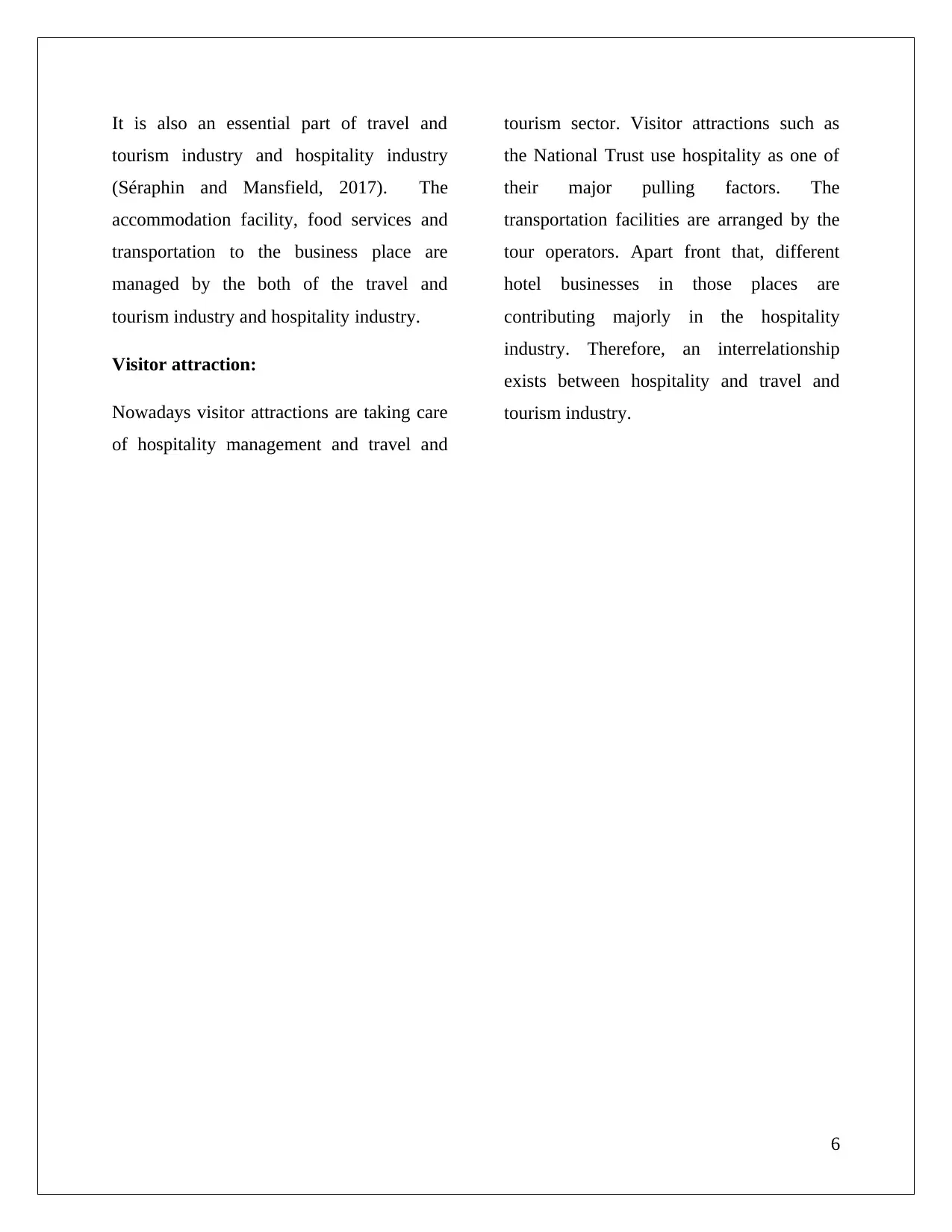
It is also an essential part of travel and
tourism industry and hospitality industry
(Séraphin and Mansfield, 2017). The
accommodation facility, food services and
transportation to the business place are
managed by the both of the travel and
tourism industry and hospitality industry.
Visitor attraction:
Nowadays visitor attractions are taking care
of hospitality management and travel and
tourism sector. Visitor attractions such as
the National Trust use hospitality as one of
their major pulling factors. The
transportation facilities are arranged by the
tour operators. Apart front that, different
hotel businesses in those places are
contributing majorly in the hospitality
industry. Therefore, an interrelationship
exists between hospitality and travel and
tourism industry.
6
tourism industry and hospitality industry
(Séraphin and Mansfield, 2017). The
accommodation facility, food services and
transportation to the business place are
managed by the both of the travel and
tourism industry and hospitality industry.
Visitor attraction:
Nowadays visitor attractions are taking care
of hospitality management and travel and
tourism sector. Visitor attractions such as
the National Trust use hospitality as one of
their major pulling factors. The
transportation facilities are arranged by the
tour operators. Apart front that, different
hotel businesses in those places are
contributing majorly in the hospitality
industry. Therefore, an interrelationship
exists between hospitality and travel and
tourism industry.
6
Paraphrase This Document
Need a fresh take? Get an instant paraphrase of this document with our AI Paraphraser
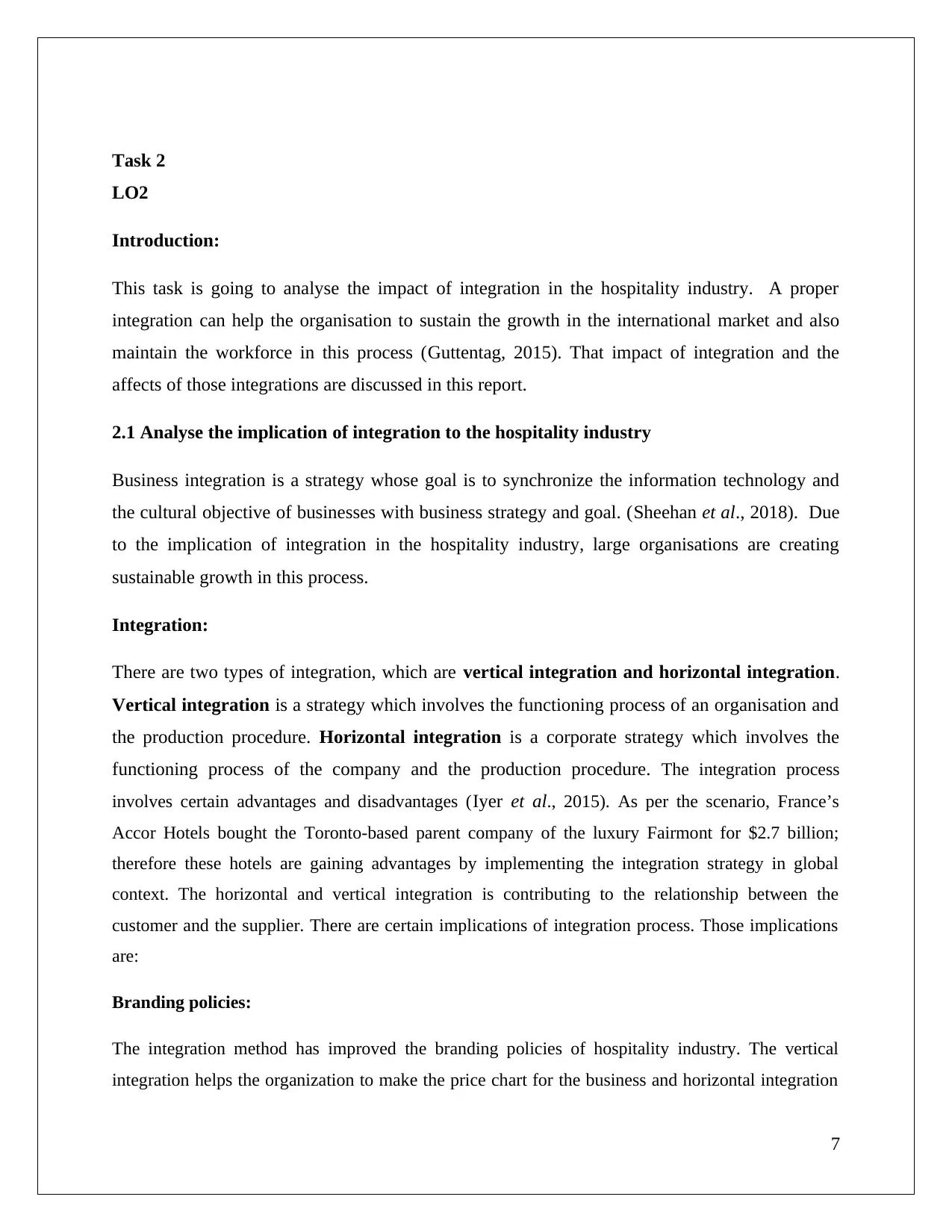
Task 2
LO2
Introduction:
This task is going to analyse the impact of integration in the hospitality industry. A proper
integration can help the organisation to sustain the growth in the international market and also
maintain the workforce in this process (Guttentag, 2015). That impact of integration and the
affects of those integrations are discussed in this report.
2.1 Analyse the implication of integration to the hospitality industry
Business integration is a strategy whose goal is to synchronize the information technology and
the cultural objective of businesses with business strategy and goal. (Sheehan et al., 2018). Due
to the implication of integration in the hospitality industry, large organisations are creating
sustainable growth in this process.
Integration:
There are two types of integration, which are vertical integration and horizontal integration.
Vertical integration is a strategy which involves the functioning process of an organisation and
the production procedure. Horizontal integration is a corporate strategy which involves the
functioning process of the company and the production procedure. The integration process
involves certain advantages and disadvantages (Iyer et al., 2015). As per the scenario, France’s
Accor Hotels bought the Toronto-based parent company of the luxury Fairmont for $2.7 billion;
therefore these hotels are gaining advantages by implementing the integration strategy in global
context. The horizontal and vertical integration is contributing to the relationship between the
customer and the supplier. There are certain implications of integration process. Those implications
are:
Branding policies:
The integration method has improved the branding policies of hospitality industry. The vertical
integration helps the organization to make the price chart for the business and horizontal integration
7
LO2
Introduction:
This task is going to analyse the impact of integration in the hospitality industry. A proper
integration can help the organisation to sustain the growth in the international market and also
maintain the workforce in this process (Guttentag, 2015). That impact of integration and the
affects of those integrations are discussed in this report.
2.1 Analyse the implication of integration to the hospitality industry
Business integration is a strategy whose goal is to synchronize the information technology and
the cultural objective of businesses with business strategy and goal. (Sheehan et al., 2018). Due
to the implication of integration in the hospitality industry, large organisations are creating
sustainable growth in this process.
Integration:
There are two types of integration, which are vertical integration and horizontal integration.
Vertical integration is a strategy which involves the functioning process of an organisation and
the production procedure. Horizontal integration is a corporate strategy which involves the
functioning process of the company and the production procedure. The integration process
involves certain advantages and disadvantages (Iyer et al., 2015). As per the scenario, France’s
Accor Hotels bought the Toronto-based parent company of the luxury Fairmont for $2.7 billion;
therefore these hotels are gaining advantages by implementing the integration strategy in global
context. The horizontal and vertical integration is contributing to the relationship between the
customer and the supplier. There are certain implications of integration process. Those implications
are:
Branding policies:
The integration method has improved the branding policies of hospitality industry. The vertical
integration helps the organization to make the price chart for the business and horizontal integration
7
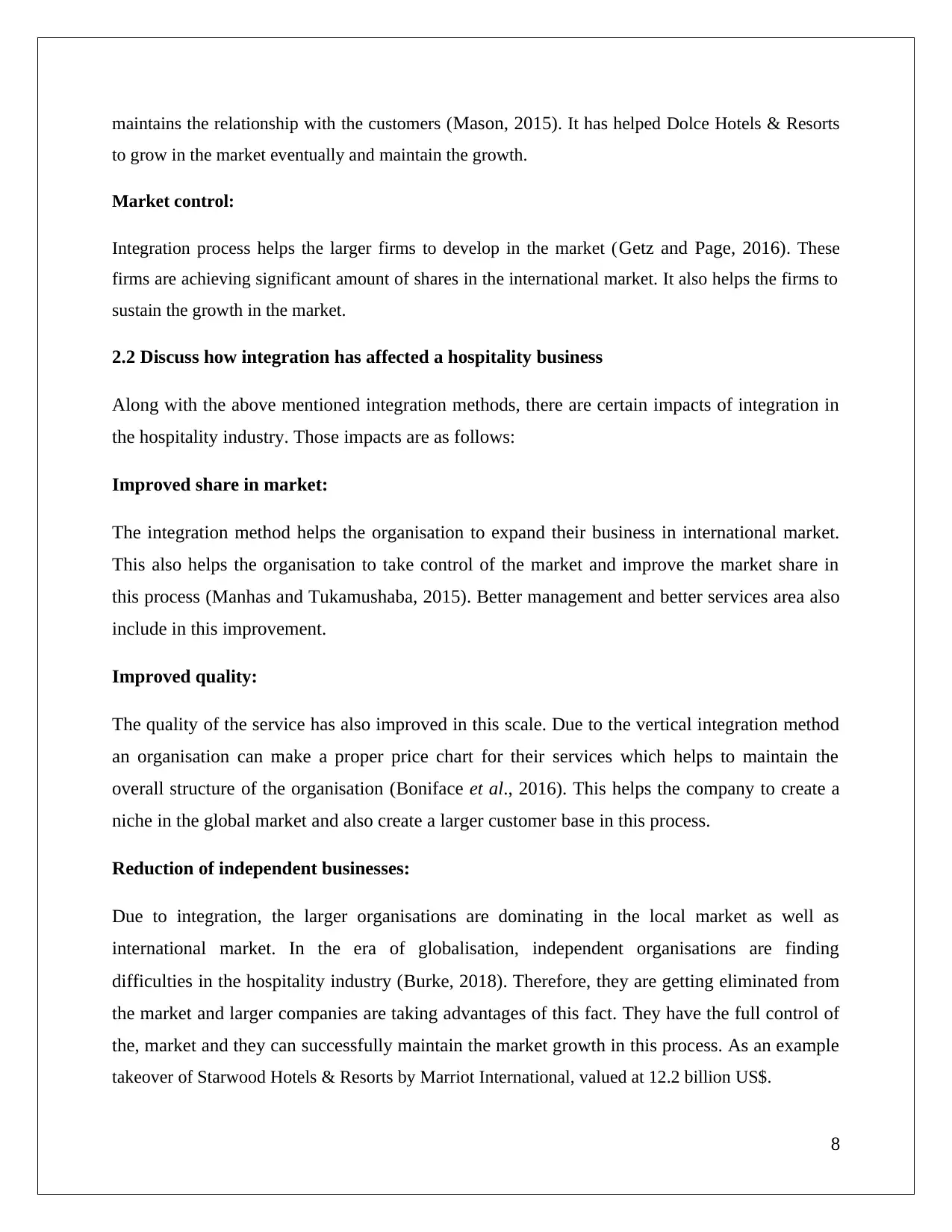
maintains the relationship with the customers (Mason, 2015). It has helped Dolce Hotels & Resorts
to grow in the market eventually and maintain the growth.
Market control:
Integration process helps the larger firms to develop in the market (Getz and Page, 2016). These
firms are achieving significant amount of shares in the international market. It also helps the firms to
sustain the growth in the market.
2.2 Discuss how integration has affected a hospitality business
Along with the above mentioned integration methods, there are certain impacts of integration in
the hospitality industry. Those impacts are as follows:
Improved share in market:
The integration method helps the organisation to expand their business in international market.
This also helps the organisation to take control of the market and improve the market share in
this process (Manhas and Tukamushaba, 2015). Better management and better services area also
include in this improvement.
Improved quality:
The quality of the service has also improved in this scale. Due to the vertical integration method
an organisation can make a proper price chart for their services which helps to maintain the
overall structure of the organisation (Boniface et al., 2016). This helps the company to create a
niche in the global market and also create a larger customer base in this process.
Reduction of independent businesses:
Due to integration, the larger organisations are dominating in the local market as well as
international market. In the era of globalisation, independent organisations are finding
difficulties in the hospitality industry (Burke, 2018). Therefore, they are getting eliminated from
the market and larger companies are taking advantages of this fact. They have the full control of
the, market and they can successfully maintain the market growth in this process. As an example
takeover of Starwood Hotels & Resorts by Marriot International, valued at 12.2 billion US$.
8
to grow in the market eventually and maintain the growth.
Market control:
Integration process helps the larger firms to develop in the market (Getz and Page, 2016). These
firms are achieving significant amount of shares in the international market. It also helps the firms to
sustain the growth in the market.
2.2 Discuss how integration has affected a hospitality business
Along with the above mentioned integration methods, there are certain impacts of integration in
the hospitality industry. Those impacts are as follows:
Improved share in market:
The integration method helps the organisation to expand their business in international market.
This also helps the organisation to take control of the market and improve the market share in
this process (Manhas and Tukamushaba, 2015). Better management and better services area also
include in this improvement.
Improved quality:
The quality of the service has also improved in this scale. Due to the vertical integration method
an organisation can make a proper price chart for their services which helps to maintain the
overall structure of the organisation (Boniface et al., 2016). This helps the company to create a
niche in the global market and also create a larger customer base in this process.
Reduction of independent businesses:
Due to integration, the larger organisations are dominating in the local market as well as
international market. In the era of globalisation, independent organisations are finding
difficulties in the hospitality industry (Burke, 2018). Therefore, they are getting eliminated from
the market and larger companies are taking advantages of this fact. They have the full control of
the, market and they can successfully maintain the market growth in this process. As an example
takeover of Starwood Hotels & Resorts by Marriot International, valued at 12.2 billion US$.
8
⊘ This is a preview!⊘
Do you want full access?
Subscribe today to unlock all pages.

Trusted by 1+ million students worldwide
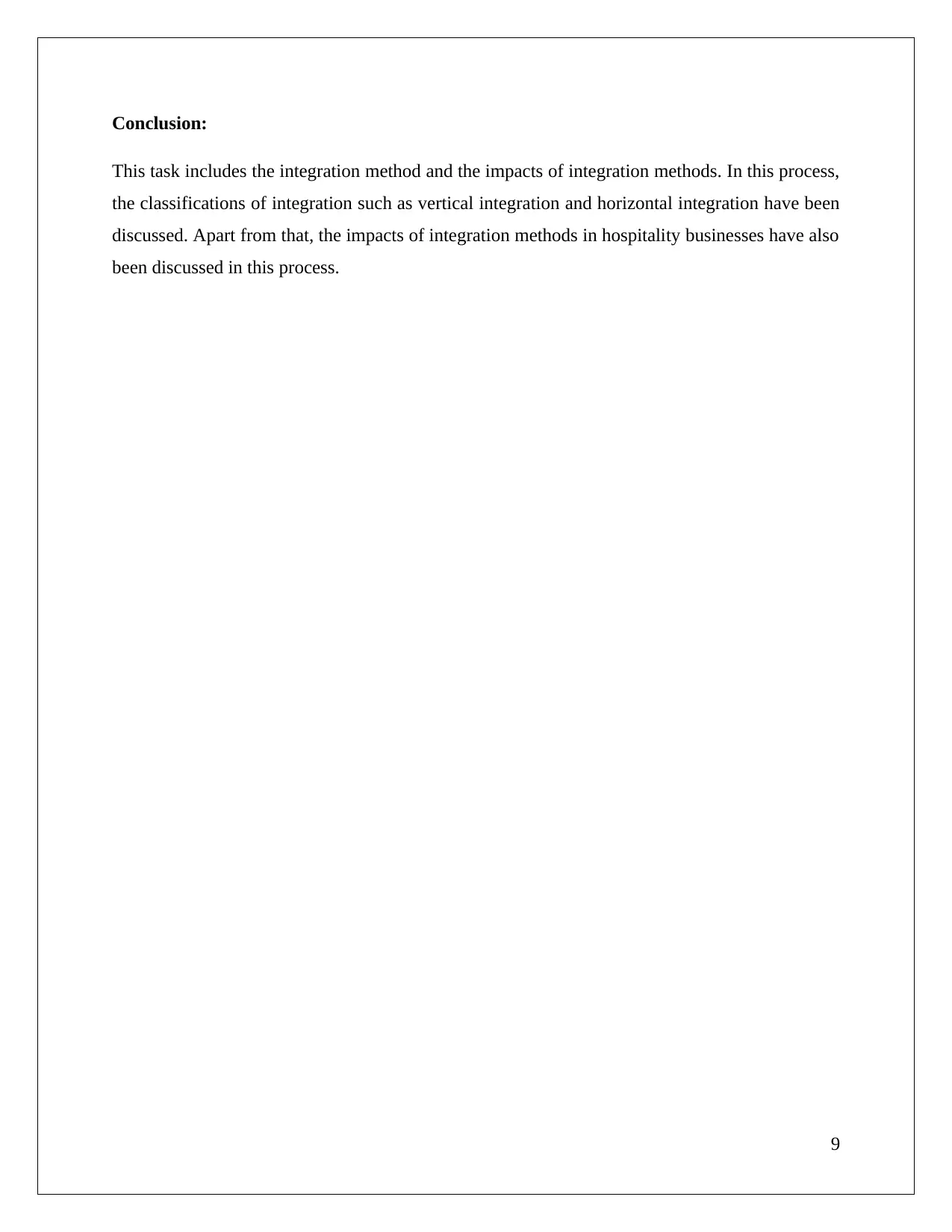
Conclusion:
This task includes the integration method and the impacts of integration methods. In this process,
the classifications of integration such as vertical integration and horizontal integration have been
discussed. Apart from that, the impacts of integration methods in hospitality businesses have also
been discussed in this process.
9
This task includes the integration method and the impacts of integration methods. In this process,
the classifications of integration such as vertical integration and horizontal integration have been
discussed. Apart from that, the impacts of integration methods in hospitality businesses have also
been discussed in this process.
9
Paraphrase This Document
Need a fresh take? Get an instant paraphrase of this document with our AI Paraphraser
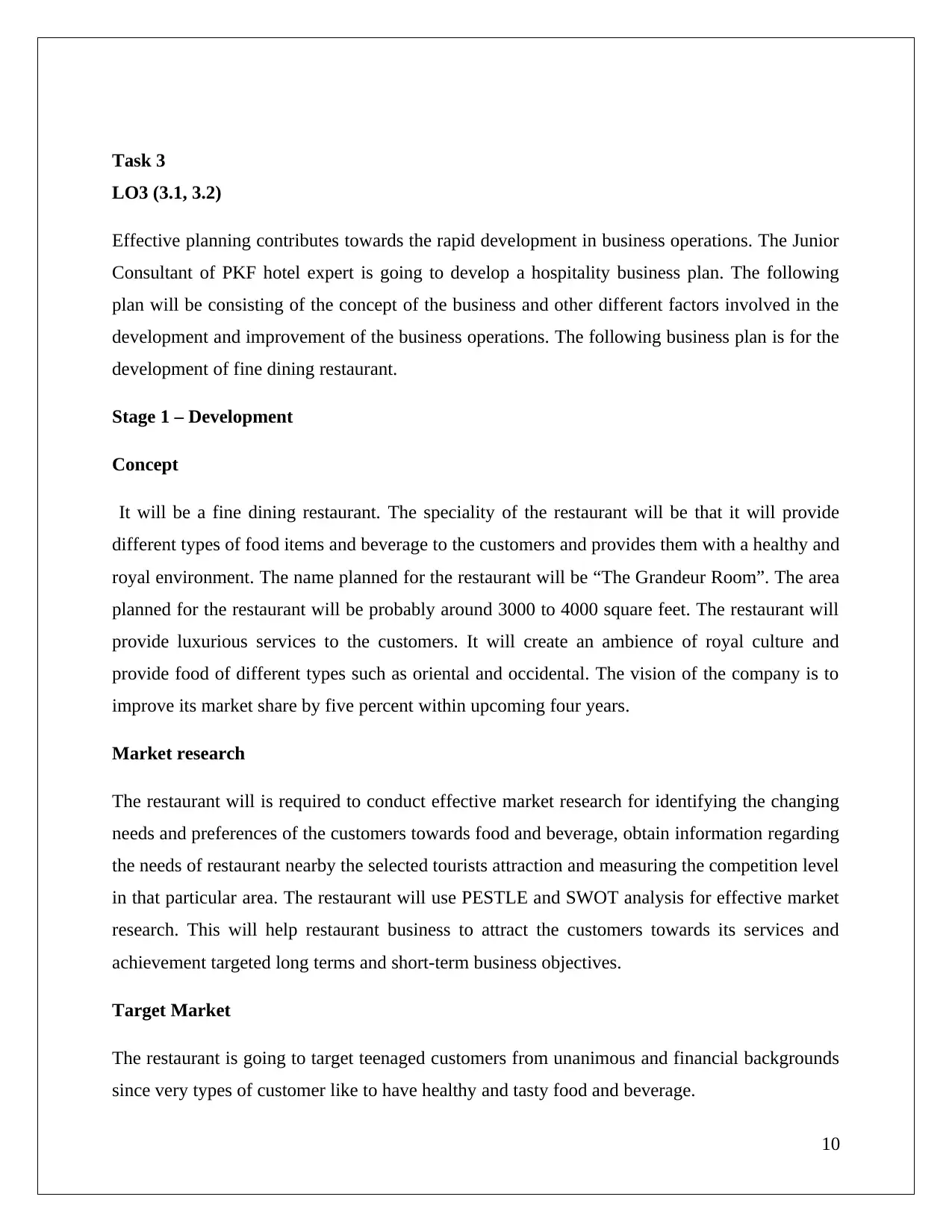
Task 3
LO3 (3.1, 3.2)
Effective planning contributes towards the rapid development in business operations. The Junior
Consultant of PKF hotel expert is going to develop a hospitality business plan. The following
plan will be consisting of the concept of the business and other different factors involved in the
development and improvement of the business operations. The following business plan is for the
development of fine dining restaurant.
Stage 1 – Development
Concept
It will be a fine dining restaurant. The speciality of the restaurant will be that it will provide
different types of food items and beverage to the customers and provides them with a healthy and
royal environment. The name planned for the restaurant will be “The Grandeur Room”. The area
planned for the restaurant will be probably around 3000 to 4000 square feet. The restaurant will
provide luxurious services to the customers. It will create an ambience of royal culture and
provide food of different types such as oriental and occidental. The vision of the company is to
improve its market share by five percent within upcoming four years.
Market research
The restaurant will is required to conduct effective market research for identifying the changing
needs and preferences of the customers towards food and beverage, obtain information regarding
the needs of restaurant nearby the selected tourists attraction and measuring the competition level
in that particular area. The restaurant will use PESTLE and SWOT analysis for effective market
research. This will help restaurant business to attract the customers towards its services and
achievement targeted long terms and short-term business objectives.
Target Market
The restaurant is going to target teenaged customers from unanimous and financial backgrounds
since very types of customer like to have healthy and tasty food and beverage.
10
LO3 (3.1, 3.2)
Effective planning contributes towards the rapid development in business operations. The Junior
Consultant of PKF hotel expert is going to develop a hospitality business plan. The following
plan will be consisting of the concept of the business and other different factors involved in the
development and improvement of the business operations. The following business plan is for the
development of fine dining restaurant.
Stage 1 – Development
Concept
It will be a fine dining restaurant. The speciality of the restaurant will be that it will provide
different types of food items and beverage to the customers and provides them with a healthy and
royal environment. The name planned for the restaurant will be “The Grandeur Room”. The area
planned for the restaurant will be probably around 3000 to 4000 square feet. The restaurant will
provide luxurious services to the customers. It will create an ambience of royal culture and
provide food of different types such as oriental and occidental. The vision of the company is to
improve its market share by five percent within upcoming four years.
Market research
The restaurant will is required to conduct effective market research for identifying the changing
needs and preferences of the customers towards food and beverage, obtain information regarding
the needs of restaurant nearby the selected tourists attraction and measuring the competition level
in that particular area. The restaurant will use PESTLE and SWOT analysis for effective market
research. This will help restaurant business to attract the customers towards its services and
achievement targeted long terms and short-term business objectives.
Target Market
The restaurant is going to target teenaged customers from unanimous and financial backgrounds
since very types of customer like to have healthy and tasty food and beverage.
10
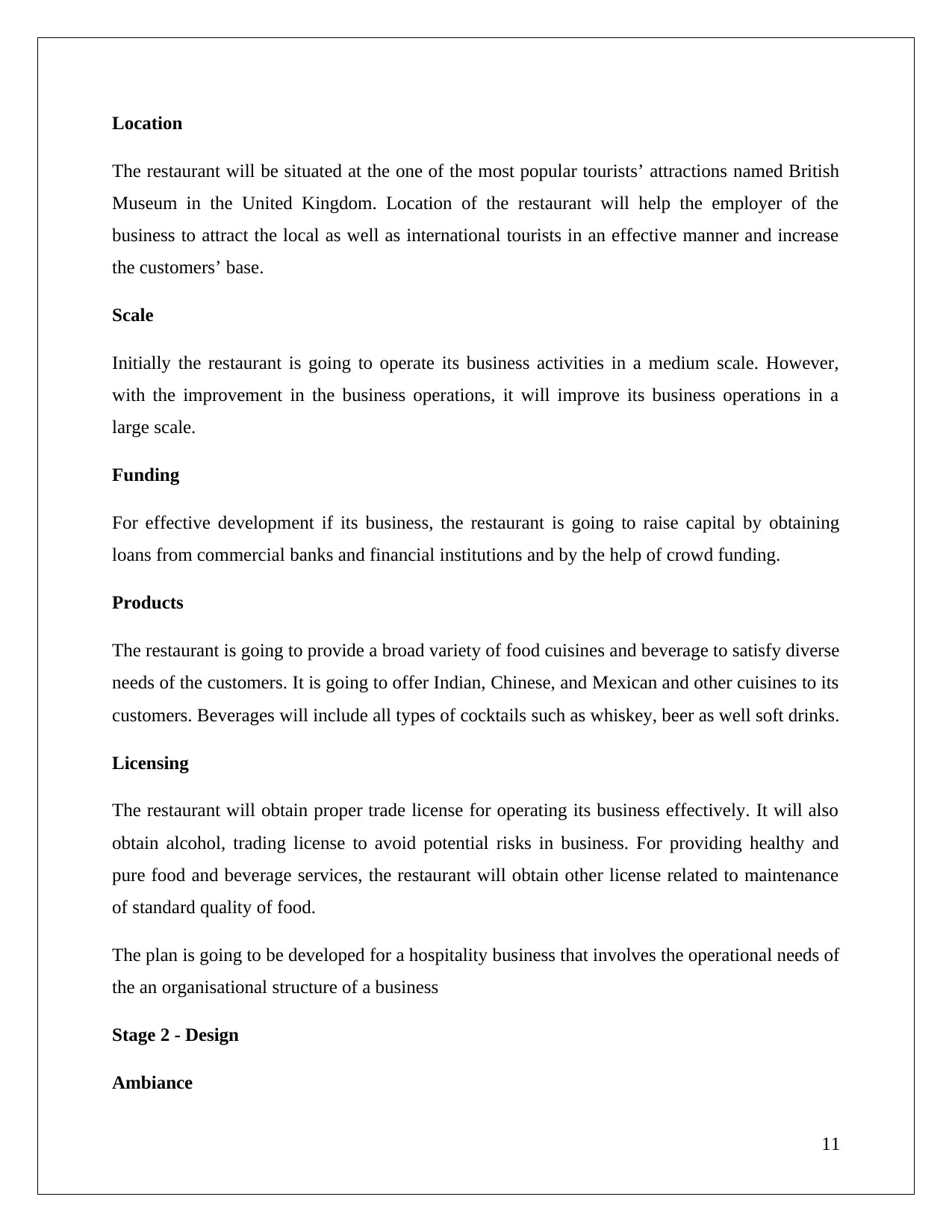
Location
The restaurant will be situated at the one of the most popular tourists’ attractions named British
Museum in the United Kingdom. Location of the restaurant will help the employer of the
business to attract the local as well as international tourists in an effective manner and increase
the customers’ base.
Scale
Initially the restaurant is going to operate its business activities in a medium scale. However,
with the improvement in the business operations, it will improve its business operations in a
large scale.
Funding
For effective development if its business, the restaurant is going to raise capital by obtaining
loans from commercial banks and financial institutions and by the help of crowd funding.
Products
The restaurant is going to provide a broad variety of food cuisines and beverage to satisfy diverse
needs of the customers. It is going to offer Indian, Chinese, and Mexican and other cuisines to its
customers. Beverages will include all types of cocktails such as whiskey, beer as well soft drinks.
Licensing
The restaurant will obtain proper trade license for operating its business effectively. It will also
obtain alcohol, trading license to avoid potential risks in business. For providing healthy and
pure food and beverage services, the restaurant will obtain other license related to maintenance
of standard quality of food.
The plan is going to be developed for a hospitality business that involves the operational needs of
the an organisational structure of a business
Stage 2 - Design
Ambiance
11
The restaurant will be situated at the one of the most popular tourists’ attractions named British
Museum in the United Kingdom. Location of the restaurant will help the employer of the
business to attract the local as well as international tourists in an effective manner and increase
the customers’ base.
Scale
Initially the restaurant is going to operate its business activities in a medium scale. However,
with the improvement in the business operations, it will improve its business operations in a
large scale.
Funding
For effective development if its business, the restaurant is going to raise capital by obtaining
loans from commercial banks and financial institutions and by the help of crowd funding.
Products
The restaurant is going to provide a broad variety of food cuisines and beverage to satisfy diverse
needs of the customers. It is going to offer Indian, Chinese, and Mexican and other cuisines to its
customers. Beverages will include all types of cocktails such as whiskey, beer as well soft drinks.
Licensing
The restaurant will obtain proper trade license for operating its business effectively. It will also
obtain alcohol, trading license to avoid potential risks in business. For providing healthy and
pure food and beverage services, the restaurant will obtain other license related to maintenance
of standard quality of food.
The plan is going to be developed for a hospitality business that involves the operational needs of
the an organisational structure of a business
Stage 2 - Design
Ambiance
11
⊘ This is a preview!⊘
Do you want full access?
Subscribe today to unlock all pages.

Trusted by 1+ million students worldwide
1 out of 19
Related Documents
Your All-in-One AI-Powered Toolkit for Academic Success.
+13062052269
info@desklib.com
Available 24*7 on WhatsApp / Email
![[object Object]](/_next/static/media/star-bottom.7253800d.svg)
Unlock your academic potential
Copyright © 2020–2025 A2Z Services. All Rights Reserved. Developed and managed by ZUCOL.





